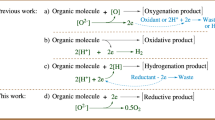Abstract
Hydrogenation/deuteration of carbon chloride (C−Cl) bonds is of high significance but remains a remarkable challenge in synthetic chemistry, especially using safe and inexpensive hydrogen donors. In this article, a visible-light-photocatalytic watersplitting hydrogenation technology (WSHT) is proposed to in-situ generate active H-species (i.e., Had) for controllable hydrogenation of aryl chlorides instead of using flammable H2. When applying heavy water-splitting systems, we could selectively install deuterium at the C−Cl position of aryl chlorides under mild conditions for the sustainable synthesis of high-valued added deuterated chemicals. Sub-micrometer Pd nanosheets (Pd NSs) decorated crystallined polymeric carbon nitrides (CPCN) is developed as the bifunctional photocatalyst, whereas Pd NSs not only serve as a cocatalyst of CPCN to generate and stabilize H (D)-species but also play a significant role in the sequential activation and hydrogenation/deuteration of C−Cl bonds. This article highlights a photocatalytic-WSHT for controllable hydrogenation/deuteration of low-cost aryl chlorides, providing a promising way for the photosynthesis of high-valued added chemicals instead of the hydrogen evolution.
Similar content being viewed by others
Reference
Agarwal V, Miles ZD, Winter JM, Eustáquio AS, El Gamal AA, Moore BS. Chem Rev, 2017, 117: 5619–5674
Ghosh I, Ghosh T, Bardagi JI, König B. Science, 2014, 346: 725–728
Wang D, Astruc D. Chem Rev, 2015, 115: 6621–6686
Qiu G, Li Y, Wu J. Org Chem Front, 2016, 3: 1011–1027
Reich HJ. J Org Chem, 2012, 77: 5471–5491
Ong DY, Tejo C, Xu K, Hirao H, Chiba S. Angew Chem Int Ed, 2017, 56: 1840–1844
Mutsumi T, Iwata H, Maruhashi K, Monguchi Y, Sajiki H. Tetrahedron, 2011, 67: 1158–1165
Douvris C, Nagaraja CM, Chen CH, Foxman BM, Ozerov OV. J Am Chem Soc, 2010, 132: 4946–4953
Guo B, Li HX, Zha CH, Young DJ, Li HY, Lang JP. ChemSusChem, 2019, 12: 1421–1427
Li J, Li X, Wang L, Hu Q, Sun H. Dalton Trans, 2014, 43: 6660–6666
Tak H, Lee H, Kang J, Cho J. Inorg Chem Front, 2016, 3: 157–163
Zhang HC, Liu RT, Zhou XG. Sci China Chem, 2014, 57: 282–288
Mao ZY, Huang SY, Gao LH, Wang AE, Huang PQ. Sci China Chem, 2014, 57: 252–264
Simon MO, Li CJ. Chem Soc Rev, 2012, 41: 1415–1427
Just-Baringo X, Procter DJ. Acc Chem Res, 2015, 48: 1263–1275
Sun B, Zhou W, Li H, Ren L, Qiao P, Li W, Fu H. Adv Mater, 2018, 30: 1804282
Li H, Cao C, Liu J, Shi Y, Si R, Gu L, Song W. Sci China Mater, 2019, 62: 1306–1314
Zhou W, Li W, Wang JQ, Qu Y, Yang Y, Xie Y, Zhang K, Wang L, Fu H, Zhao D. J Am Chem Soc, 2014, 136: 9280–9283
Cuerva JM, Campaña AG, Justicia J, Rosales A, Oller-López JL, Robles R, Cárdenas DJ, Buñuel E, Oltra JE. Angew Chem, 2006, 118: 5648–5652
Yan K, Wu G. ACS Sustain Chem Eng, 2015, 3: 779–791
Xiao S, Dai W, Liu X, Pan D, Zou H, Li G, Zhang G, Su C, Zhang D, Chen W, Li H. Adv Energy Mater, 2019, 9: 1900775
Zhang G, Ou W, Wang J, Xu Y, Xu D, Sun T, Xiao S, Wang M, Li H, Chen W, Su C. Appl Catal B-Environ, 2019, 245: 114–121
Liu C, Chen Z, Su C, Zhao X, Gao Q, Ning GH, Zhu H, Tang W, Leng K, Fu W, Tian B, Peng X, Li J, Xu QH, Zhou W, Loh KP. Nat Commun, 2018, 9: 80–88
Qiu C, Xu Y, Fan X, Xu D, Tandiana R, Ling X, Jiang Y, Liu C, Yu L, Chen W, Su C. Adv Sci, 2019, 6: 1801403
Soulard V, Villa G, Vollmar DP, Renaud P. J Am Chem Soc, 2018, 140: 155–158
Loh YY, Nagao K, Hoover AJ, Hesk D, Rivera NR, Colletti SL, Davies IW, MacMillan DWC. Science, 2017, 358: 1182–1187
Wang X, Zhu MH, Schuman DP, Zhong D, Wang WY, Wu LY, Liu W, Stoltz BM, Liu WB. J Am Chem Soc, 2018, 140: 10970–10974
Yu RP, Hesk D, Rivera N, Pelczer I, Chirik PJ. Nature, 2016, 529: 195–199
Katsnelson A. Nat Med, 2013, 19: 656
Mullard A. Nat Rev Drug Discov, 2017, 16: 305
Xu Y, He X, Zhong H, Singh DJ, Zhang L, Wang R. Appl Catal BEnviron, 2019, 246: 349–355
Li H, Chen G, Yang H, Wang X, Liang J, Liu P, Chen M, Zheng N. Angew Chem Int Ed, 2013, 52: 8368–8372
Huang X, Tang S, Mu X, Dai Y, Chen G, Zhou Z, Ruan F, Yang Z, Zheng N. Nat Nanotech, 2011, 6: 28–32
Tauster SJ. Acc Chem Res, 1987, 20: 389–394
Li XH, Antonietti M. Chem Soc Rev, 2013, 42: 6593–6604
Kisch H. Acc Chem Res, 2017, 50: 1002–1010
Zhou W, Fu H. Inorg Chem Front, 2018, 5: 1240–1254
Zhang GQ, Liu G, Xu Y, Yang J, Li Y, Sun X, Chen W, Su CL. Sci China Mater, 2018, 61: 1033–1039
Ren JT, Yuan K, Wu K, Zhou L, Zhang YW. Inorg Chem Front, 2019, 6: 366–375
Acknowledgements
This work was supported by the National Natural Science Foundation of China (21972094, 51701127, 21401190), China Postdoctoral Science Foundation (2017M612709), Guangdong Special Support Program, Pengcheng Scholar Program, Shenzhen Peacock Plan (KQJSCX20170727100802505, KQTD2016053112042971), Educational Commission of Guangdong Province (2016KTSCX126), Foundation for Distinguished Young Talents in Higher Education of Guangdong (2018KQNCX221), Shenzhen Innovation Program (JCYJ 20170818142642395). We are thankful for the support of TEM characterizations from the Electron Microscopy Center of Shenzhen University and computational source supplied by the National Supercomputing Center in Shenzhen (Shenzhen Cloud Computing Center).
Author information
Authors and Affiliations
Corresponding author
Ethics declarations
Conflict of interest The authors declare that they have no conflict of interest.
Rights and permissions
About this article
Cite this article
Ling, X., Xu, Y., Wu, S. et al. A visible-light-photocatalytic water-splitting strategy for sustainable hydrogenation/deuteration of aryl chlorides. Sci. China Chem. 63, 386–392 (2020). https://doi.org/10.1007/s11426-019-9672-8
Received:
Accepted:
Published:
Issue Date:
DOI: https://doi.org/10.1007/s11426-019-9672-8




